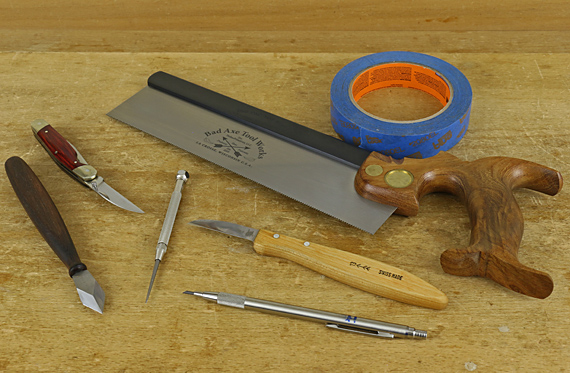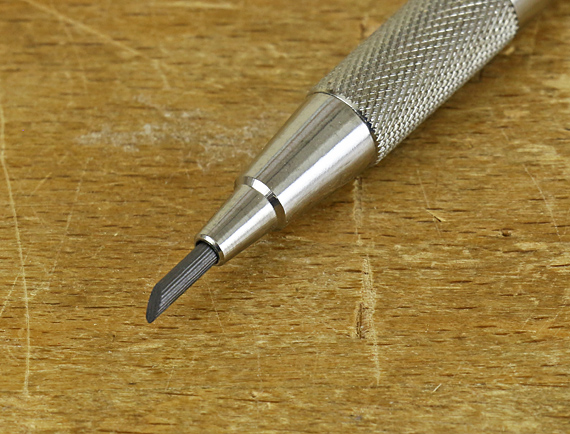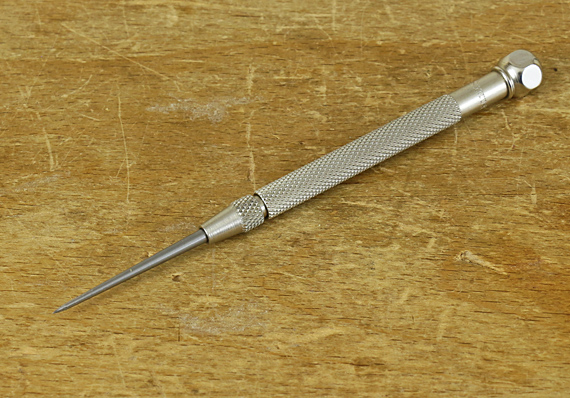
A critical step in hand-cut dovetailing is accurately marking out the second piece – usually the pin board – from the completed first piece – usually the tailboard.
Sure, to make a good dovetail joint, you have to be able to reliably saw to a line and chisel to a line. You also have to understand the mechanics of the joint to appreciate how to tweak the contact surfaces and where you have a bit of tolerance and where you don’t. But if the transfer step is inaccurate, it’s all a losing battle.
So, let’s look at several options.
Keep in mind that all of this depends on several variables including pin width, the texture of the wood, and your personal eyesight, lighting, type of saw, and technique. An effective marking out in cherry using a ripcut dozuki may be difficult in red oak using a Western backsaw.

A plain old pencil seems too crude for the precision required in dovetailing and yet it can work well for some. All of the pencil mark is in the keeper wood, so you have to saw to one side of it without touching it at all. A very clean, consistent line gives the best chance for success. A 2mm drafting lead sharpened on 320-grit sandpaper to a chisel point (above) can produce an almost knife-quality line, especially with 2H lead on a diffuse-porous wood like cherry. That said, a pencil is not my preference.

I’ve used a scriber more than anything else for this job, perhaps because that is what I used long ago while learning (first learning, that is). I prefer the type of point on the Starrett scriber (above), which ends in a small, straight conical taper. Unlike a gradual curved taper, I can clearly tell when the scriber is or is not up against the wall of the tail wood.
Used properly, the scriber point hugs the wall of the tail wood as it bites into the endgrain of the pin board, without any chance of it cutting into the side grain of the tail as a knife might. Thus, the bottom of the tiny V groove created by the scribe point is exactly under the tail wood wall.
This works best if the sawn (and possibly pared) surface of the tail is straight and clean. Otherwise, the scribed line will be not straight and therefore probably confusing to follow with the saw.
I have found the scriber effective in ring porous woods like red oak as well as fine, diffuse-porous woods like pear. The downside is the scribed line is not quite as clean and fine as a knife line.
Next: a look at different marking knives and more.
By the way, go here for my free 42-page Dovetail Instruction Guide that I wrote several years ago for Craftsy. It really gets down to the sawdust and shavings to lead you to success.


The link for the PDF at Craftsy does not seem to work.
Thanks, John.
Craftsy was a cool group. I enjoyed working with them. It was acquired by NBC Universal in 2017. Its name was then changed to Bluprint, along with a significant change in their business model. Bluprint closed in May, 2020.
https://craftindustryalliance.org/nbcuniversal-to-close-bluprint/
TN Marketing announced July 2020 that they acquired the assets of Bluprint.
https://craftindustryalliance.org/bluprint-assets-acquired-by-tn-marketing-access-to-content-to-be-preserved/
It appears that the name is back to Craftsy!
https://www.craftsy.com/faq/?brand_id=360000786271&locale_id=1&return_to=https%3A%2F%2Fhelp.mybluprint.com%2Fhc%2Fen-us%2Farticles%2F360045785811-welcome-back-to-craftsy-faq×tamp=1601162570
Unfortunately, I could not find my Dovetail Guide on their site, though the many 600-1000-word articles I wrote for them seem to be available. Search for them under “porcaro.”
I will try to contact them to see what happened to the Dovetail Guide. It truly is a useful guide.
Thanks again for the heads-up, John.
Rob